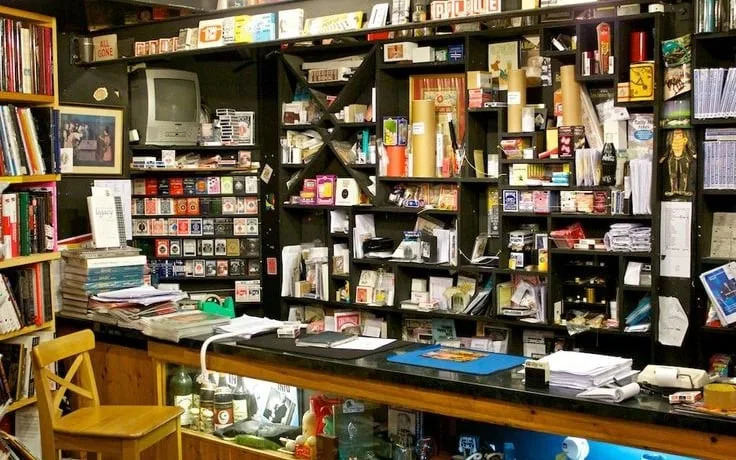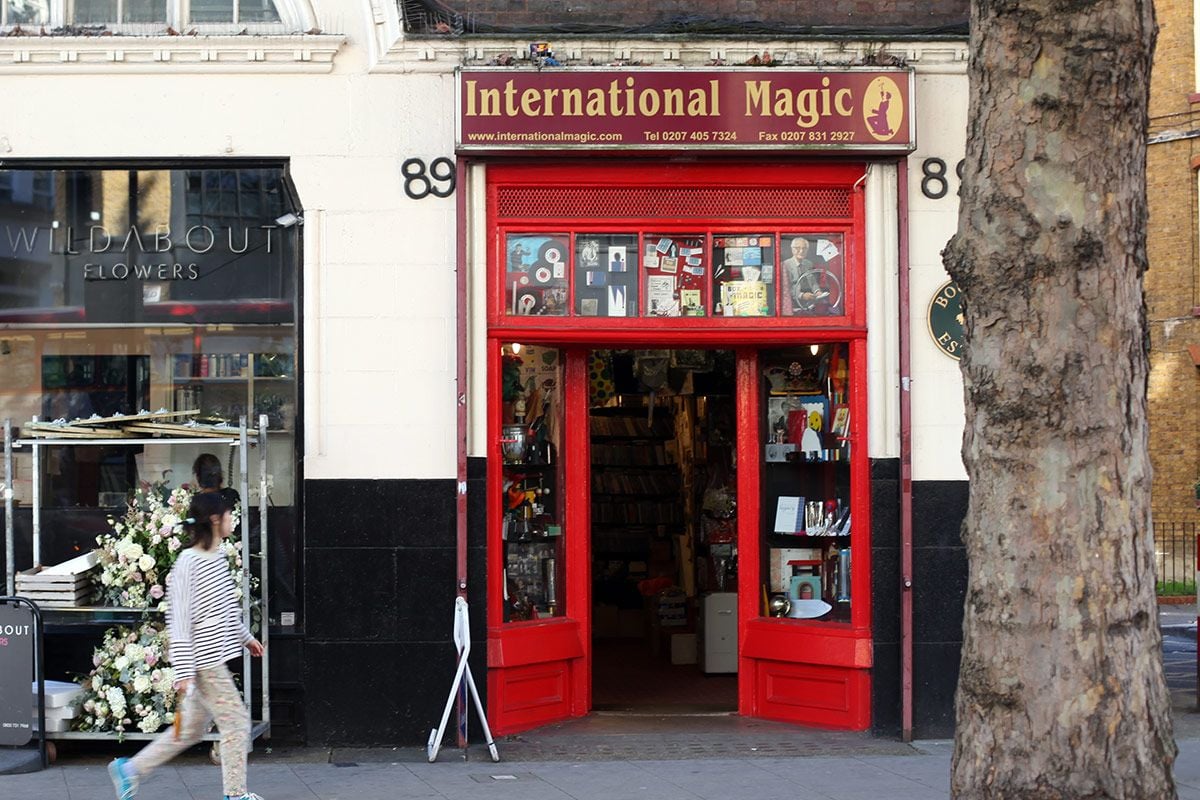It’s been a long time since magic was at the heart of pop culture, when Saturday night telly drew millions by having men disappear glamorous assistants, and Sunday morning markets were filled with men hustling with nothing but three cups, a ball and chutzpah.
But in Clerkenwell, there is somewhere where the magic has never faded. For almost 70 years, there has been the International Magic Shop. It opened in 1958, first on Saffron Hill, moved briefly to Leather Lane, and in ’63 found its forever home on Clerkenwell Road. It is a small, hole-in-the-wall kind of place, with a brass-handled, red front door flanked by two large windows under a sign where a man in tails crouches, holding billiard balls aloft. He is burgundy in relief against a gold oval background, like a faded photo in a locket.

The shop’s famous frontage (Press handout)
Tommy Cooper to the Krays
If the name did not give it away, the windows would. They are more like glass fronted cabinets, each a teetering pile of tricks and illusions, of big boxes promising party goodies for beginners and neat cases containing secrets not found elsewhere. It has looked this way for most of its life, since Ron MacMillan first opened its doors. It’s MacMillan in that locket. He was just in his mid-twenties then, and must have been riding high on his own success: in 1957, he’d won the International Brotherhood of Magicians British Ring Shield for a routine where, in front of an increasingly astonished audience, he produced 14 billiard balls from around his body, held, somehow, between his fingers all at once. A framed photo of him performing it is there in the shop. In part because of this routine, the Symphony of the Spheres, he was known as the Man with the Golden Hands. The 1960s were good to him: he hung out with Tommy Cooper and performed across town including, once, for the Krays.
The 1960s were good for magic too. When it opened, it was one of eight within walking distance. Now it is the only shop of its kind anywhere in the capital. Back then, MacMillan was used to magician‘s apparatus: his Symphony required a holder in his sleeve. And so he filled the shop with other devices and mechanisms, and began a magazine of sorts, Magic Info, which ran for more than 100 issues. Magicians soon came to see what was on offer, and to pick up a copy.
This is a jewel box filled floor-to-ceiling with spell books, ways to fake telepathy, enchanted dice…
The walls pay tribute to all those who visited: besides Cooper, in came Channing Pollock (so famous in his time that he performed at Prince Rainier and Grace Kelly’s wedding), Tom Ogden (the highlight of Ronald Reagan’s 81st birthday), Dai Vernon, Paul Daniels, Stephen Mulhern. Countless others, not all pictured: some magicians never reveal their secrets… or where they buy them.
Tricks aside, one thing the crowds would have also seen was Ron’s son, Martin, who would pop in after school and began working there full time at 15. He still runs the shop today, as he has for decades, helped by a team that are fixtures too: Marco, for 35 years, Barry for 30. Its longevity might be down to its home, on the street level of the council-owned Radcliff Buildings, which helps keep rent stable; International Magic had concessions in Hamleys and Harrods once, though these are gone now. Without all the pressure, Martin keeps it looking as it should be: a jewel box jumble sale filled floor-to-ceiling with a library of books, linking rings, ways to fake telepathy. Enchanted dice. But alongside the tricks for parties and the kits to get novices interested, stage magicians are catered for too: all one has to do is ask; there is more hidden away. There are DVDs here, too, with instructions that have never seen the internet. Some, anyway: piracy is apparently rife in magic.

The counter in the shop (Press handout)
Her Majesty’s magician
Even the shop itself is a kind of illusion: outside, it is tiny, but inside it goes back surprisingly far. It was once a desk in a cubby hole — the tracks and rings for the curtains that once hid its wares in the back are still there — but despite everything there, is not cramped. It has a worn red carpet, lots of wood, the same warm feeling as a pub.
Martin, in that way, is International Magic’s landlord, like his dad was before him. Ron used to sit in a chair, until he passed. His wife, Martin’s mum, now in Ireland, still watches what’s going on over the CCTV. But Martin is there in person, usually at the counter, behind him an impossibly large collection of Bicycle Cards, and is often fiddling with something, doing a little sleight of hand. He is the genial kind, and performs the illusions his shop sells with delicate, intricate movements: that he doesn’t perform on stage is another kind of mystery. Though it might be to do with Ron’s Day, the annual magic show created by his father in 1972 that ran until 2016. It was not a slight undertaking: performances included a number at The London Palladium and Her Majesty’s Theatre. Martin wryly says he loved it — when it was all over.
If magic does have another moment, this is the place to come to — but there is a sense that now, as much as anything, it is a curiosity of a kind, a tourist attraction. Magicians talk, and when they come to London, seek it out. For those not after a new top hat, or an endless run of handkerchiefs, the shop is in fact a magician’s wardrobe, and one that, once inside, travels you back in time, to a disappeared world, keeping a family tradition alive. Which is, you admit, one hell of a trick.
89 Clerkenwell Road, EC1, internationalmagic.com
